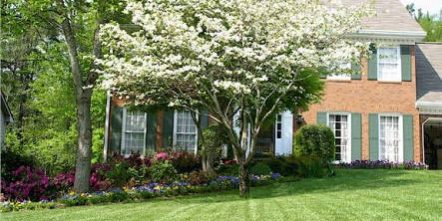Fescue is a fast growing turf grass that stays some shade of green year round. It looks its best fall through spring, but has problems trying to grow in hard soil or in full sunshine. It is usually planted from seed rather than grown from sod. ‘Kentucky 31’ is the original Fescue grass, but is lighter green, clumpier, and less hardy than the new turf type tall Fescue. Fescue is a cool season grass, and typically suffers considerable damage from fungus and brown patch in the summer. Fescue lawns need to be aerated and overseeded every fall.
Establishing a Fescue Lawn
Fescue lawns may partially die every summer. A well rooted, mature fescue lawn will hold up fairly well to summer heat if it is well cared for. Poorly rooted lawns suffer the most damage. The timing of seeding or sodding your lawn is very important. Newly seeded lawns and overseeding should be done in mid-September. Fertilization (and liming if necessary) should be done at the time of seeding, again in November and again in late-February. The timing of the seeding and the three fertilizations are critical to making your grass as mature as possible to survive the winter freezes and summer heat.
Fescue sodding should be done in late fall or early spring. If sodding in the fall, apply insecticide such as Triazion to prevent army worm damage. For seed or sod, the soil should be tilled (or core aerated for top dressing).
Turf type fescues are the best grass seeds. Using a sun or shade tolerant variety in the appropriate sun conditions will provide the best results.
Seeding and sodding lawns at other times of the year will most likely cause severe damage during the severe heat of the summer. Sodding fescue during the summer can result in a wasted investment. Lawns seeded in the spring and summer will popup and look nice for a short period but will then die during the summer heat.
Fescue Lawn Care and Maintenance
Fescue should be fertilized during its season of rapid growth, from fall to early spring. You should usually apply fertilizer in September, in early November, and in mid February. Use any brand of turf fertilizer at the rate recommended on the bag. Turf Fescue looks best when mowed 2″ high. In dry summers and when growing in heavy shade, mowing to 3″ high helps the grass tolerate its environment. Fescue is very susceptible to fungus. If the grass stays wet for more than 12 hours, fungus may develop. Fungus is therefore more common in areas that receive no morning sun, thus remaining wet from the morning dew.





